#overpopulation
Earth’s Population Could Reach 12.3 Billion by 2100, Scientists Say
http://www.sci-news.com/othersciences/anthropology/science-earths-population-12-3-billion-02157.html
Post link
THE BIG PICTURE
World Population: Where it’s thick and where it’s thin
-The growing population of the world, now estimated to be over 7 billion, marks a global milestone and presents obvious challenges for the planet. (41 photos total)
Post link
Over-populated or under-developed? The real story of population growth
The world population looks set to reach 9.7 billion by 2050, but what’s behind the big numbers? We look at the complex demographic shifts in play Global population hit 7.3 billion midway through 2015, an increase of 2 billion since 1990.
Source:http://ift.tt/29kyCao
Post link
GSV24: “Tomorrow and Tomorrow and Tomorrow”!
GSV24: “Tomorrow and Tomorrow and Tomorrow”!
The last bonusisode of season one is one last quick spin through immortality, 1954’s “The Big Trip Up Yonder” / “Tomorrow and Tomorrow and Tomorrow”…
Stay tuned for the very long, very fun season one finale, coming soon!
Trippy futuristic dystopian thriller, Z.P.G. – about a misguided couple (Oliver Reed and Geraldine Chaplin) living in an overpopulated society, who decide to have a baby – was delivered on May 25, 1972.
Post link

A new Cato Institute study that relies on 37 years worth of data for 50 foundational commodities covering energy, food, materials, and metals to develop a new framework to measure resource availability finds that,instead of making resources scarcer, population growth has gone hand in hand with greater resource abundance.
The report builds on the famous wager between biologist Paul Ehrlich and economist and former Cato Senior Fellow Julian Simon on the effect of population growth on the Earth’s resources. While Ehrlich warned that population growth could deplete resources and lead to global catastrophe, Simon saw humans as the “ultimate resource” who could innovate their way out of such shortages. The Ehrlich-Simon wager tracked the real price of a basket of five raw materials between 1980 and 1990, finding as Simon hypothesized that all measured commodities decreased in price by an average of 57.6 percent, despite a population increase of 873 million.
Expanding on Simon’s original insight, the new study looks at 50 different commodities and analyzes a longer time period between 1980 and 2017, finding that the real price of the commodities decreased by 36.3%.
The study also introduces a new measure termed “time-price,” the time that an average human must work in order to earn enough money to buy a particular commodity. They find the time-price of their basket of 50 commodities has fallen by 64.%. Put differently, commodities that took 60 minutes of work to buy in 1980 took only 21 minutes of work to purchase in 2017. Should the current trend continue, commodities could become 50 percent cheaper every 26 years.
In addition, the authors develop the concept of price elasticity of population (PEP), which allows them to estimate the effect of population growth on the availability of resources. Over the time period studied the population grew from 4.46 billion to 7.55 billion, a 69.3% increase. The PEP indicates that the time-price of the basket of commodities declined by 0.934% for every 1% of increase in population. Every additional human being born on our planet appears to make resources proportionally more plentiful for the rest of us.
Using the PEP values the authors form the Simon Abundance Framework, which describes progression from decreasing abundance at the one end to increasing abundance at the other end. The authors conclude that humanity is experiencing superabundance with the time-price commodities decreasing at a faster proportional rate than the population is increasing.
Finally, the authors produce the Simon Abundance Index (SAI) that represents the ratio of the change in population over the change in the time-price. Between 1980 and 2017, resource availability increased at a compounded annual growth rate of 4.32%, meaning Earth was 379.6% more abundant in 2017 than it was in 1980.
The time-price of commodities could fall a further 29% over the next 37 years as humanity continues to make resources more plentiful through greater efficiency of use, increased supply, and the development of cheaper substitutes.However,for this trend to continue, market incentives and the price mechanism must endure.
The world is a closed system in the way that a piano is a closed system. The instrument has only 88 notes, but those notes can be played in a nearly infinite variety of ways. The same applies to our planet. The Earth’s atoms may be fixed, but the possible combinations of those atoms are infinite. What matters, then, is not the physical limits of our planet, but human freedom to experiment and reimagine the use of resources that we have.
Pod Vending Machine - Robotic Architecture for Tomorrow’s Population Surge
In what has to be one of my favourite concepts I’ve seen lately for tackling the Earth’s increasing population, this student proposal for a tower that prints homes to order combines modular styling with robotic character.
Prospective home-owners would order their customised ‘pods’ via a self-service interface in the lobby which would be fed to a robotic 3D printing machine at the top of the ‘scraper. Once the pods are constructed, they are lowered down the face of the tower via a robotic arm and slotted into the framework based on the layout desired by the client.
The concept’s designer - Malaysian designer Haseef Rafiei - wanted to take the Japanese obsession with vending machines and evolve it to the next level. The tower also boasts green credentials; with every pod capable of being reorganised, removed and recycled if needed. The automated nature of construction would also cut time, labour and materials.
The project earned Rafiei an honourable mention in this year’s skyscraper competition. It’s a little industrial and perhaps a tad dystopian to anyone with a fear of robots, but I love this idea. Looks like something lifted straight out of Blade Runner.
More at the designer’s site here.
Post link

John Brunner: Stand on Zanzibar (1968)























